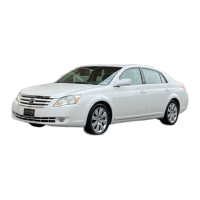Do you have a question about the Toyota Avalon 2006 and is the answer not in the manual?
Provides a general understanding of the vehicle's operational features and controls.
Details the layout and identification of components on the instrument panel.
Explains the gauges, indicators, and warning lights within the instrument cluster.
Lists and describes various warning lights and indicator symbols on the instrument panel.
Covers the operation and security features related to vehicle keys and doors.
Explains the functionality and usage of the wireless remote control for vehicle access.
Details the operation, features, and precautions for the smart key system.
Explains the operation of power windows, including automatic and jam protection functions.
Details how to open the trunk using the smart key system.
Explains how to set and operate the vehicle's theft deterrent system for security.
Introduces the vehicle's systems designed for occupant safety during driving and collisions.
Covers the adjustment and safety precautions for front and rear seats.
Explains the proper use, precautions, and fastening of seat belts for all occupants.
Details the function, operation, and safety precautions for SRS airbags.
Provides essential guidance on selecting and installing child restraint systems safely.
Covers the adjustment and operation of the tilt/telescopic steering wheel and mirrors.
Explains the operation of the auto anti-glare inside rear view mirror.
Details the usage and adjustment of the vehicle's sun visors.
Explains the operation of all exterior and interior lights, wipers, and defogger systems.
Details the manual and automatic operation of headlights and turn signals.
Explains how to activate and use the emergency hazard warning lights.
Covers the operation of windshield wipers, including intermittent and automatic modes.
Provides an overview of the vehicle's gauges, meters, and service reminder indicators.
Explains the function and operation of the fuel gauge and low fuel warning light.
Lists and explains various warning lights and buzzers and recommended actions.
Covers the operation of the ignition switch, automatic transmission, and parking brake.
Details the operation of the automatic transmission, including shift lock and modes.
Explains how to operate and use the cruise control system for maintaining speed.
Provides comprehensive information on the dynamic laser cruise control system's operation and features.
Covers the features, operation, and controls of the vehicle's audio system.
Provides basic instructions and tips for operating the vehicle's audio system effectively.
Details the components, controls, and operation of the vehicle's air conditioning system.
Explains the function of each button and dial for the air conditioning system.
Provides information on the air conditioning filter's function and replacement procedure.
Covers various other interior and convenience equipment not detailed in previous sections.
Explains the operation and display patterns of the vehicle's central information display.
Details the display of driving range, elapsed time, and average fuel consumption.
Instructions for setting and adjusting the vehicle's clock.
Explains how to use and calibrate the vehicle's compass system.
Instructions for programming and operating the HomeLink garage door opener system.
Provides essential information and checks required before driving the vehicle.
Offers tips for the initial break-in period to ensure vehicle longevity and economy.
Details fuel type requirements, octane ratings, and tank capacity.
Highlights safety precautions regarding engine exhaust fumes and system integrity.
Covers maintenance tasks related to the vehicle's engine and chassis components.
Detailed steps and safety precautions for checking and topping up engine oil.
Explains how to check the engine coolant level and the proper coolant type.
Instructions for checking the brake fluid level and understanding its normal consumption.
Emphasizes the importance of checking tire inflation pressure regularly and provides instructions.
Covers how to check tires for wear indicators and when replacement is needed.
Explains the procedure and benefits of rotating tires to equalize wear and extend life.
Covers common do-it-yourself maintenance tasks for the vehicle's electrical components.
Detailed instructions and safety precautions for checking the vehicle's battery condition.
Explains how to check for blown fuses and replace them correctly.
Step-by-step instructions for removing and replacing worn wiper blades.
Instructions for checking and adjusting the aim of the vehicle's headlights.
Provides instructions and safety warnings for replacing various vehicle light bulbs.
Lists key dimensions and weight specifications for the vehicle.
Provides technical details about the vehicle's engine specifications.
Details fuel type, octane rating, and tank capacity requirements.
Lists essential service specifications for engine oil, coolant, and transmission fluid.
Contains information on tire sizes, inflation pressures, and load limits.
Provides a detailed list of fuse locations and their corresponding circuits.
Introduces the vehicle's systems designed for occupant safety during driving and collisions.
Explains the vehicle's event data recorder system and the data it collects.
Provides a general understanding of the vehicle's operational features and controls.
Details the layout and identification of components on the instrument panel.
Explains the gauges, indicators, and warning lights within the instrument cluster.
Lists and describes various warning lights and indicator symbols on the instrument panel.
Covers the operation and security features related to vehicle keys and doors.
Explains the functionality and usage of the wireless remote control for vehicle access.
Details the operation, features, and precautions for the smart key system.
Explains the operation of power windows, including automatic and jam protection functions.
Details how to open the trunk using the smart key system.
Explains how to set and operate the vehicle's theft deterrent system for security.
Introduces the vehicle's systems designed for occupant safety during driving and collisions.
Covers the adjustment and safety precautions for front and rear seats.
Explains the proper use, precautions, and fastening of seat belts for all occupants.
Details the function, operation, and safety precautions for SRS airbags.
Provides essential guidance on selecting and installing child restraint systems safely.
Covers the adjustment and operation of the tilt/telescopic steering wheel and mirrors.
Explains the operation of the auto anti-glare inside rear view mirror.
Details the usage and adjustment of the vehicle's sun visors.
Explains the operation of all exterior and interior lights, wipers, and defogger systems.
Details the manual and automatic operation of headlights and turn signals.
Explains how to activate and use the emergency hazard warning lights.
Covers the operation of windshield wipers, including intermittent and automatic modes.
Provides an overview of the vehicle's gauges, meters, and service reminder indicators.
Explains the function and operation of the fuel gauge and low fuel warning light.
Lists and explains various warning lights and buzzers and recommended actions.
Covers the operation of the ignition switch, automatic transmission, and parking brake.
Details the operation of the automatic transmission, including shift lock and modes.
Explains how to operate and use the cruise control system for maintaining speed.
Provides comprehensive information on the dynamic laser cruise control system's operation and features.
Covers the features, operation, and controls of the vehicle's audio system.
Provides basic instructions and tips for operating the vehicle's audio system effectively.
Details the components, controls, and operation of the vehicle's air conditioning system.
Explains the function of each button and dial for the air conditioning system.
Provides information on the air conditioning filter's function and replacement procedure.
Covers various other interior and convenience equipment not detailed in previous sections.
Explains the operation and display patterns of the vehicle's central information display.
Details the display of driving range, elapsed time, and average fuel consumption.
Instructions for setting and adjusting the vehicle's clock.
Explains how to use and calibrate the vehicle's compass system.
Instructions for programming and operating the HomeLink garage door opener system.
Provides essential information and checks required before driving the vehicle.
Offers tips for the initial break-in period to ensure vehicle longevity and economy.
Details fuel type requirements, octane ratings, and tank capacity.
Highlights safety precautions regarding engine exhaust fumes and system integrity.
Covers maintenance tasks related to the vehicle's engine and chassis components.
Detailed steps and safety precautions for checking and topping up engine oil.
Explains how to check the engine coolant level and the proper coolant type.
Instructions for checking the brake fluid level and understanding its normal consumption.
Emphasizes the importance of checking tire inflation pressure regularly and provides instructions.
Covers how to check tires for wear indicators and when replacement is needed.
Explains the procedure and benefits of rotating tires to equalize wear and extend life.
Covers common do-it-yourself maintenance tasks for the vehicle's electrical components.
Detailed instructions and safety precautions for checking the vehicle's battery condition.
Explains how to check for blown fuses and replace them correctly.
Step-by-step instructions for removing and replacing worn wiper blades.
Instructions for checking and adjusting the aim of the vehicle's headlights.
Provides instructions and safety warnings for replacing various vehicle light bulbs.
Lists key dimensions and weight specifications for the vehicle.
Provides technical details about the vehicle's engine specifications.
Details fuel type, octane rating, and tank capacity requirements.
Lists essential service specifications for engine oil, coolant, and transmission fluid.
Contains information on tire sizes, inflation pressures, and load limits.
Provides a detailed list of fuse locations and their corresponding circuits.
Introduces the vehicle's systems designed for occupant safety during driving and collisions.
Explains the vehicle's event data recorder system and the data it collects.
| Brand | Toyota |
|---|---|
| Model | Avalon 2006 |
| Category | Automobile |
| Language | English |












